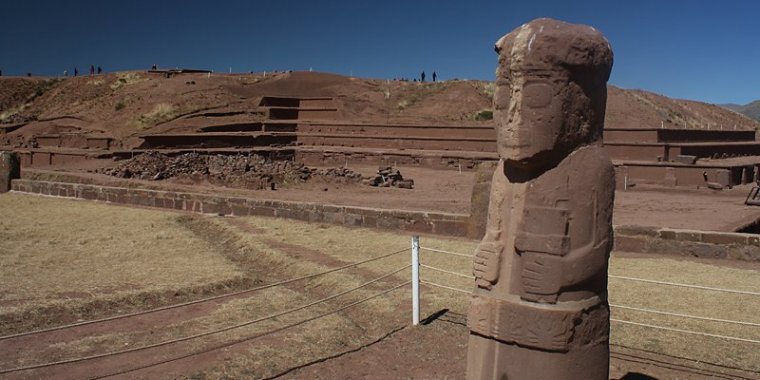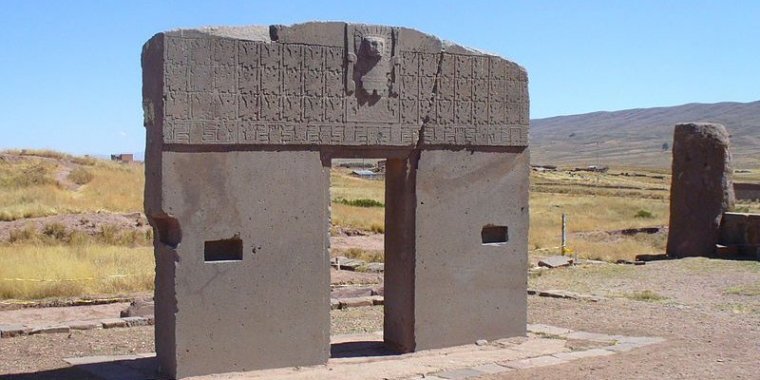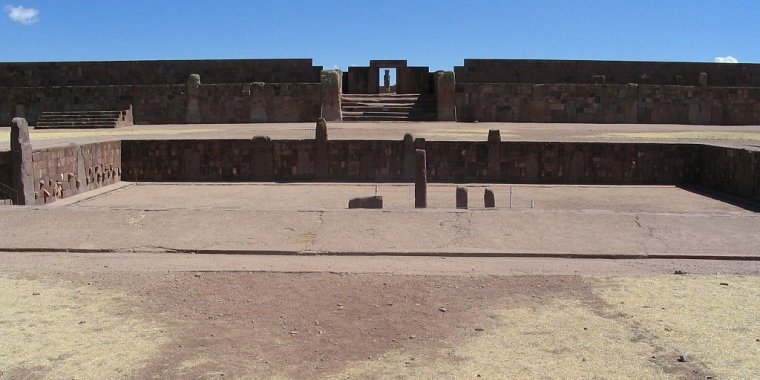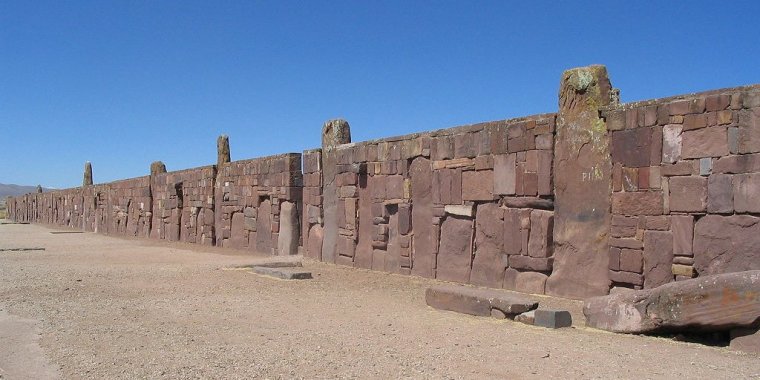| Published in Destinations |
Tiwanaku, Bolivia
Tiwanaku (Tiahuanaco or Tiahuanacu) is a Pre-Columbian archaeological site in western Bolivia. The site was first recorded in written history by Spanish conquistador Pedro Cieza de León. He came upon the remains of Tiwanaku in 1549 while searching for the Inca capital in Qullasuyu.
Get in
The admission fee for foreigners Bs100. Locals pay Bs15.
Getting there is rather easy. If you're staying in El Centro (the city), take a taxi to, or a minibus with the "Cementerio" flap on the window to the Cemetery. Across the street from the cemetery's main gate, there are florists and to the right of this area are minibuses headed to Tiwanaku. You shouldn't pay more than Bs15-20. Expect a 90-minute drive, buy some snacks and make sure the prices aren't too expensive from them either.
Also, when the drivers head up to El Alto on the road to Tiwanaku, they will most likely pick up more passengers if the bus or minibus isn't full. There usually isn't much traffic on the road out of El Alto, so besides this everything should be fine. some drivers drive fast so they won't waste time, but they are experienced so don't feel nervous. You might also want to choose to sit near a window or out of the sunlight.
The altitude at Tiwanaku is a bit higher than that of El Alto's, as a tourist you're most likely not going to get used to this. You can also book a tour through the many tour operators in La Paz. Most of these appear to be in Spanish only.
Get around
This is where you should stay, nowhere else to go to. There are only small villages in the surrounding areas of Tiwanaku and the site around it.
What to See in Tiwanaku
You can see remains of a Pre-Incan civilization of the ancient Aymara. The Aymara had a vast empire that stretched from the Atacama Desert to Cochabamba and today's northern Argentina. This monumental city in the Bolivian highlands 4,000 m (13,000 feet) above sea level and one of the around 1000 recognized World Heritage Sites is the most remarkable historical ruin in Bolivia.
Tiwanaku is surrounded by mountain ranges, with Lake Titicaca on its west side (though not visible). The massive, solid blocks of a stone not indigenous to the flat plateau give rise to the site's nickname, "the Stonehenge of the Americas"--and, over the years, they have given rise to some other worldly theories of how the site came to be. Even though the Inca invaders and later the Spanish colonizers used the huge rocks of the former city to paving their streets and construct buildings, large parts are still there and reconstructed.
In large part, the archaeological site is still covered and research is in progress. At the museum containing most of the amazing things built by the Tiwanakan people, pictures aren't allowed but sometimes people take them, anyway. The museum contains lots of pottery and handicrafts, and also a skeleton that is about 13,000 years old.
The structures that have been excavated by researchers at Tiwanaku include the Akapana, Akapana East, and Pumapunku stepped platforms, the Kalasasaya, the Kheri Kala, and Putuni enclosures, and the Semi-Subterranean Temple. These may be visited by the public.
• The Akapana is an approximately cross-shaped pyramidal structure that is 257 m wide, 197 m broad at its maximum, and 16.5 m tall.
• The Akapana East was built on the eastern side of early Tiwanaku. Later it was considered a boundary between the ceremonial center and the urban area. It was made of a thick, prepared floor of sand and clay, which supported a group of buildings.
• The Pumapunku is a man-made platform built on an east–west axis like the Akapana. It is a rectangular, terraced earthen mound faced with megalithic blocks. It is 167.36 m wide along its north–south axis and 116.7 m broad along its east–west axis, and is 5 m tall. Identical 20-meter-wide projections extend 27.6 meters north and south from the northeast and southeast corners of the Pumapunku. Walled and unwalled courts and an esplanade are associated with this structure.
• A prominent feature of the Pumapunku is a large stone terrace; it is 6.75 by 38.72 meters in dimension and paved with large stone blocks. It is called the "Plataforma Lítica". The Plataforma Lítica contains the largest stone block found in the Tiwanaku site.
• The Kalasasaya is a large courtyard more than 300 feet long, outlined by a high gateway. It is located to the north of the Akapana and west of the Semi-Subterranean Temple. Within the courtyard is where explorers found the Gateway of the Sun. Since the late 20th century, researchers have theorized that this was not the gateway's original location.
• Near the courtyard is the Semi-Subterranean Temple; a square sunken courtyard that is unique for its north–south rather than east–west axis. The walls are covered with tenon heads of many different styles, suggesting that the structure was reused for different purposes over time. It was built with walls of sandstone pillars and smaller blocks of Ashlar masonry.
What to Do in Tiwanaku
• Take as many pictures as you can. This site is beautiful, the architecture and style is impressive. Don't cross over signs or anything: you'll upset the security guards there and might be kicked off grounds. Otherwise, you have quite a lot of freedom there to walk wherever you want.
• Visit Lake Titicaca at a 30-min drive; the boat ride is about US$5.
• Visit the Pariti Island with more ruins (not fenced, Aymara tombs and a ceramic museum - this is an all-day trip and can cost US$20-30).
• The Main Plaza, numerous sculptures around the plaza, a 400-year-old colonial Church, and ask the neighbors to show their personal monoliths, mummies, ceramics, their families decades ago. The Fernandez family in the main plaza has a 9 ft (2.7 m) original monolith (monolito Zunagua) in their back yard.
Buy
Many indigenous women will be selling pottery, scarves, clothes, crafts, and other handmade things. They do not really charge much, and these items are worth it for the price. You'll probably only come here once in your life, so you might want to make sure to buy things you'll have to remember. Some weigh a couple of pounds, so when packing your luggage at the end of visiting Bolivia, put these things in your carrying bag.
Eat and Drink
There are a couple of restaurants near the museum. They are a bit expensive but the food is exquisite. Make sure to be careful eating fish or other seafood: they should be well cooked, especially since you're probably not a native.
You'll find people selling water and beverages around. At the restaurants, they have more variety.
Sleep
• Hotel Akapana, with hot water, restaurant, and the owner speaks English. It is across the street from the Tiwanaku Museum and a five-minute walk to the ruins. (Wikivoyage, Wikipedia)

Monolith Fraile and Akapana pyramid. ![]()
YOU MAY ALSO LIKE






 If you own or manage a travel-related business such as a hotel, a bed-and-breakfast, a restaurant, a pub or a cafeteria, you can create a web page for your business for free on Titi Tudorancea Travel Info. » |


